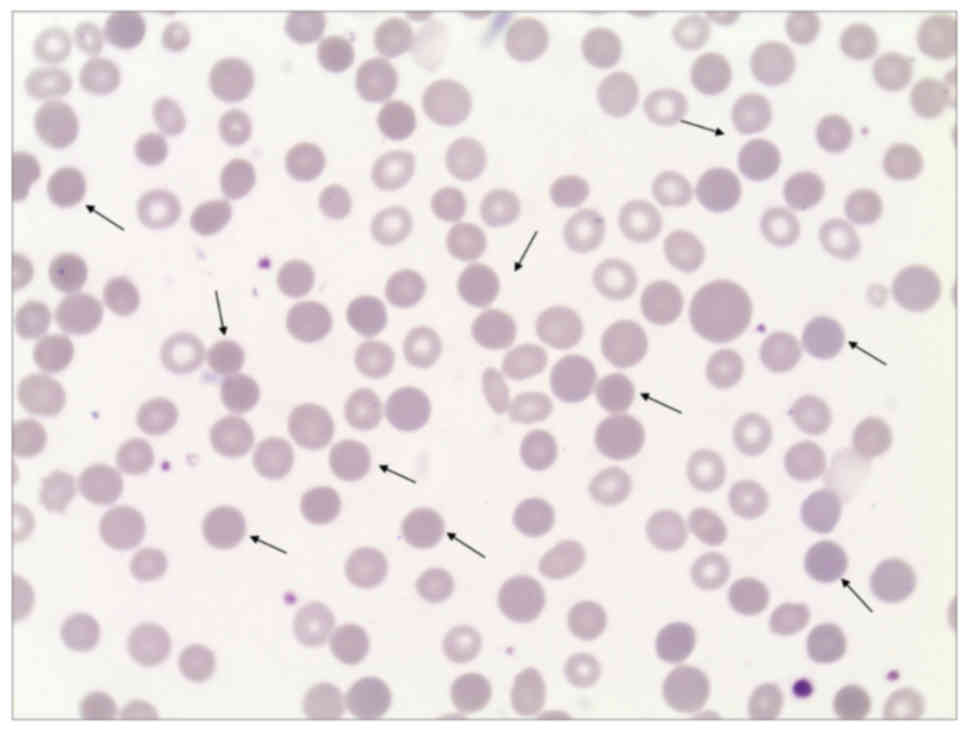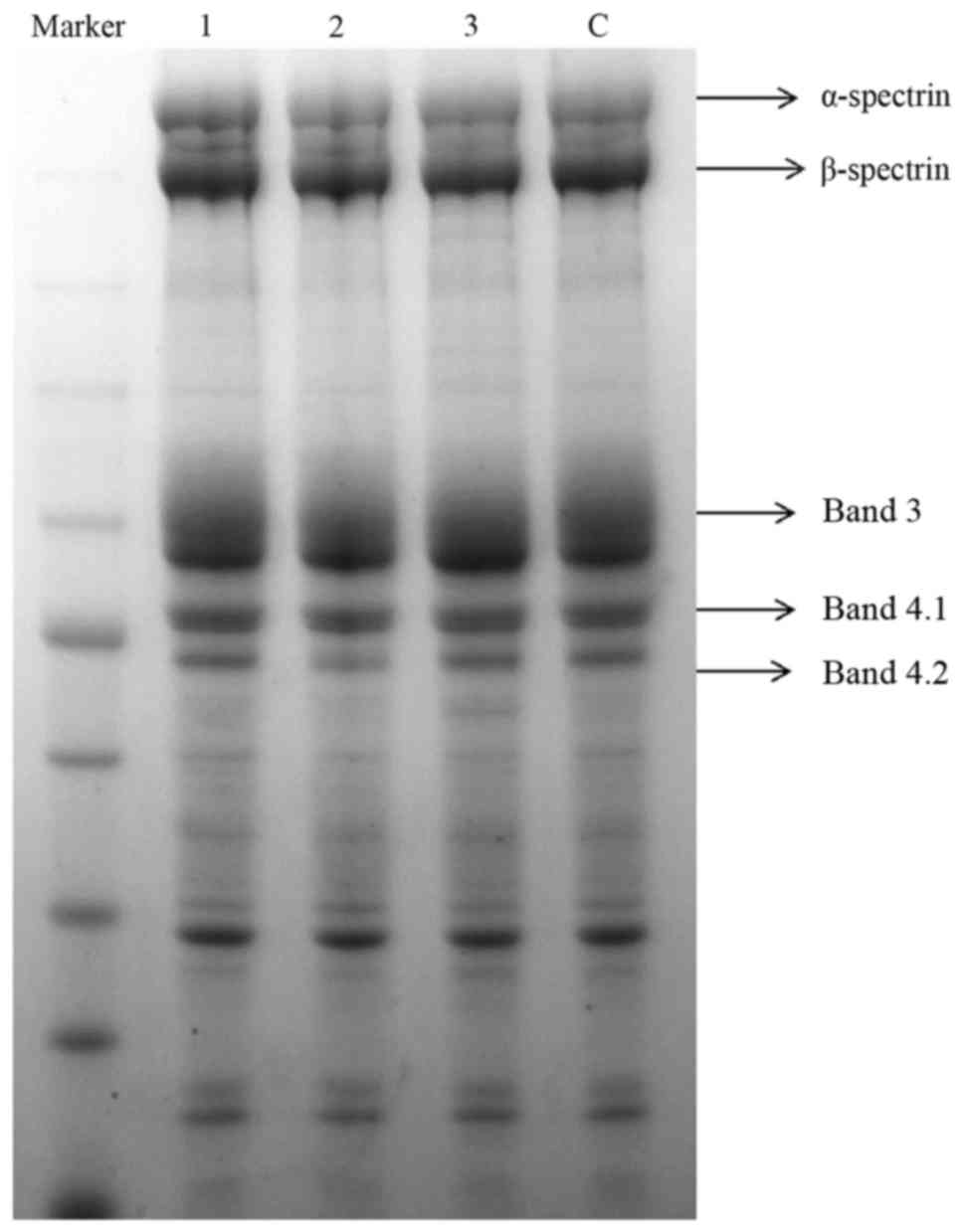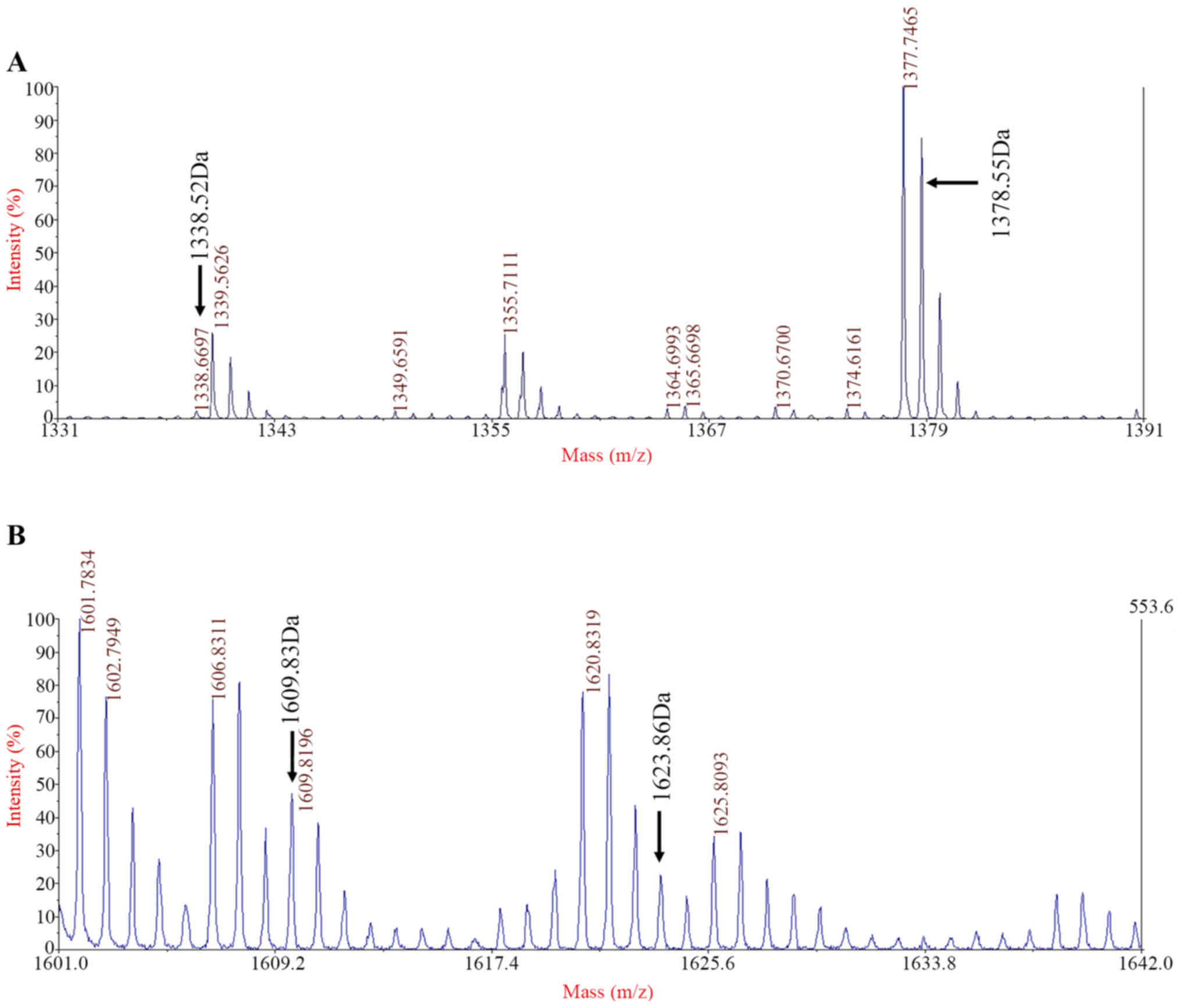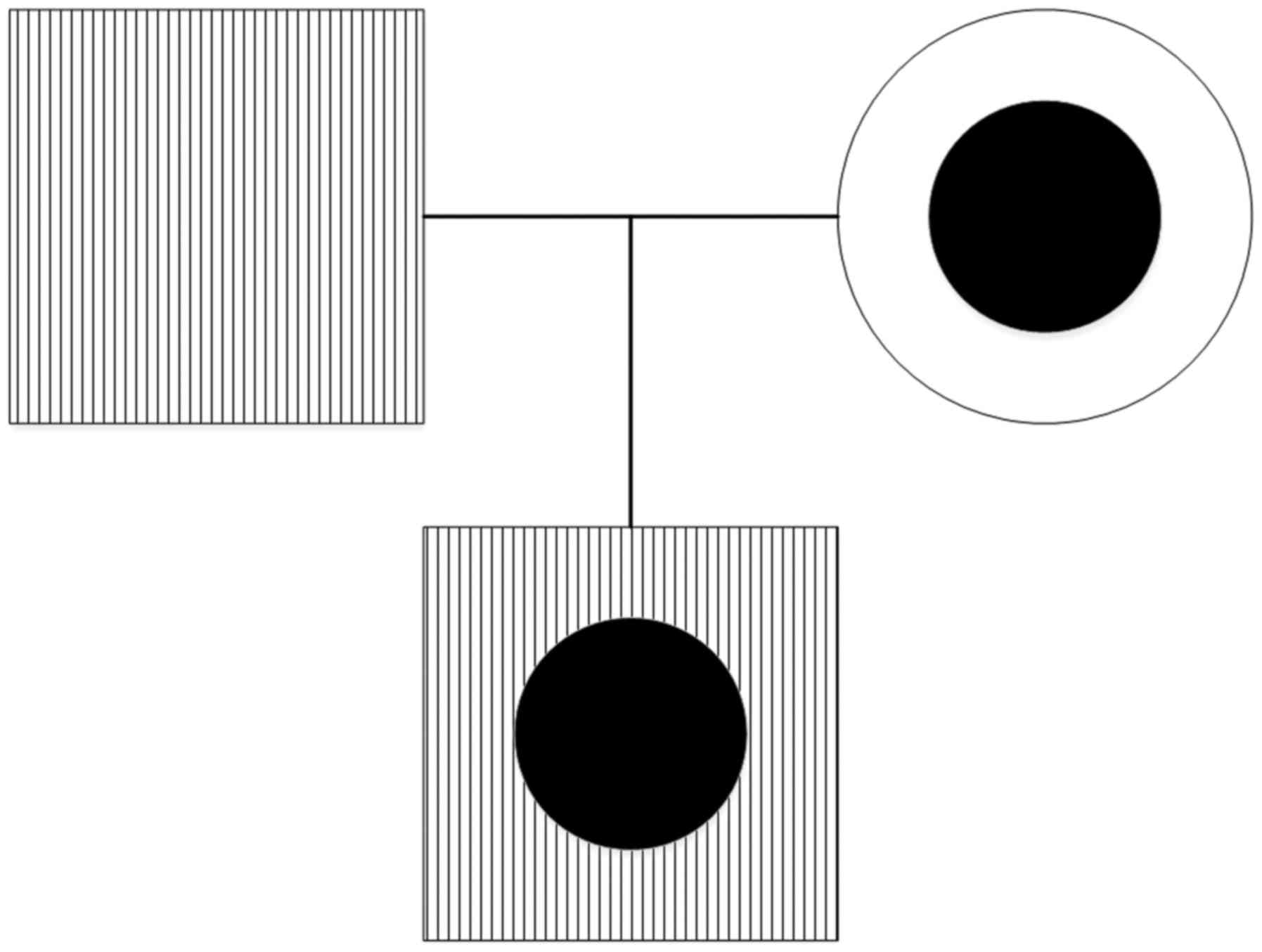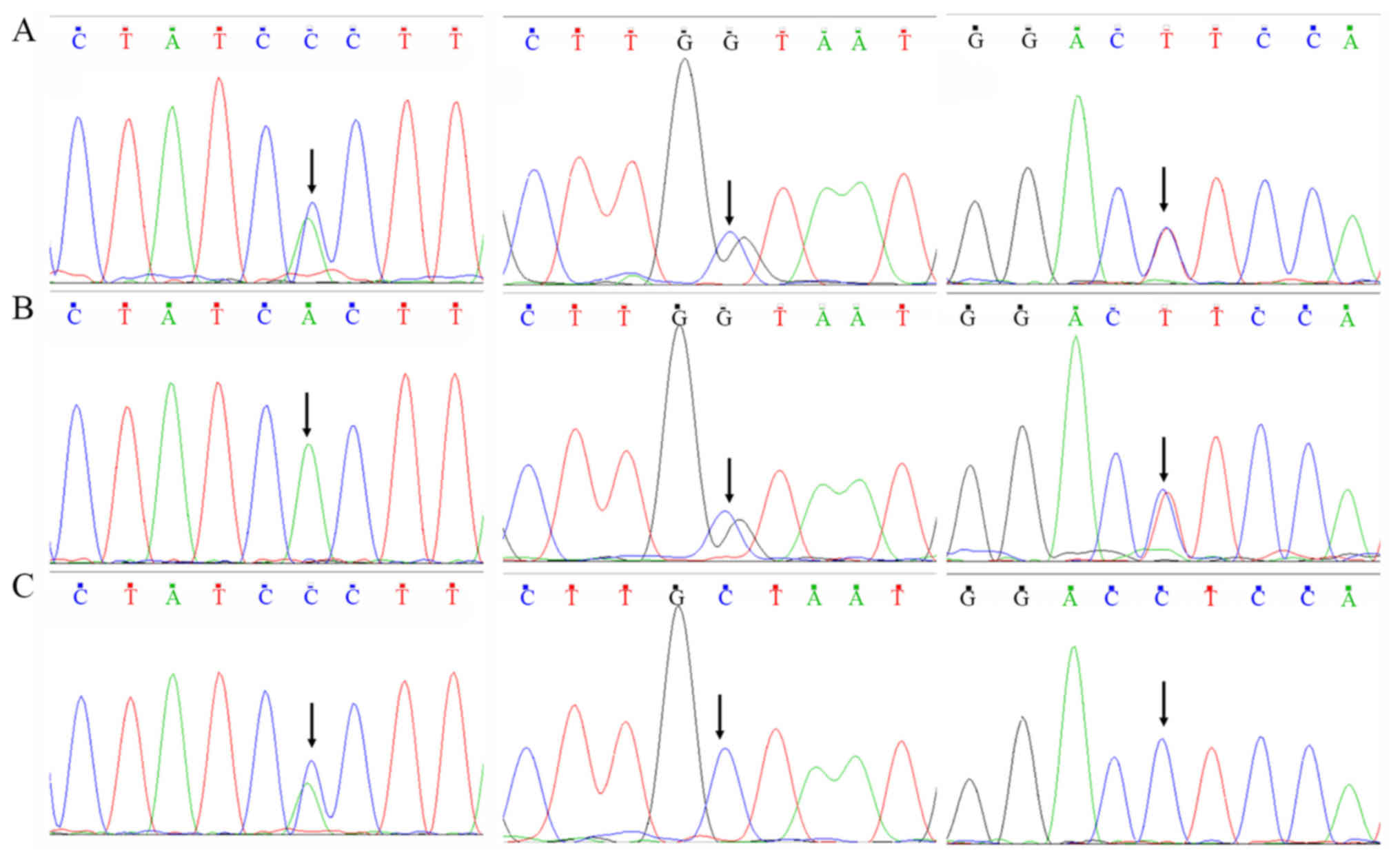|
1
|
Yawata Y, Kanzaki A, Yawata A, Doerfler W,
Ozcan R and Eber SW: Characteristic features of the genotype and
phenotype of hereditary spherocytosis in the Japanese population.
Int J Hematol. 71:118–135. 2000.PubMed/NCBI
|
|
2
|
Bolton-Maggs PH, Langer JC, Iolascon A,
Tittensor P and King MJ; General Haematology Task Force of the
British Committee for Standards in Haematology, : Guidelines for
the diagnosis and management of hereditary spherocytosis − 2011
update. Br J Haematol. 156:37–49. 2012. View Article : Google Scholar : PubMed/NCBI
|
|
3
|
King MJ, Garçon L, Hoyer JD, Iolascon A,
Picard V, Stewart G, Bianchi P, Lee SH and Zanella A; International
Council for Standardization in Haematology, : ICSH guidelines for
the laboratory diagnosis of nonimmune hereditary red cell membrane
disorders. Int J Lab Hematol. 37:304–325. 2015. View Article : Google Scholar : PubMed/NCBI
|
|
4
|
Ciepiela O, Kotuła I, Górska E,
Stelmaszczyk-Emmel A, Popko K, Szmydki-Baran A, Adamowicz-Salach A
and Demkow U: Delay in the measurement of eosin-5′-maleimide (EMA)
binding does not affect the test result for the diagnosis of
hereditary spherocytosis. Clin Chem Lab Med. 51:817–823. 2013.
View Article : Google Scholar : PubMed/NCBI
|
|
5
|
Rungaldier S, Oberwagner W, Salzer U,
Csaszar E and Prohaska R: Stomatin interacts with GLUT1/SLC2A1,
band 3/SLC4A1, and aquaporin-1 in human erythrocyte membrane
domains. Biochim Biophys Acta. 1828:956–966. 2013. View Article : Google Scholar : PubMed/NCBI
|
|
6
|
Fairbanks G, Steck TL and Wallach DF:
Electrophoretic analysis of the major polypeptides of the human
erythrocyte membrane. Biochemistry. 10:2606–2617. 1971. View Article : Google Scholar : PubMed/NCBI
|
|
7
|
Gharahdaghi F, Weinberg CR, Meagher DA,
Imai BS and Mische SM: Mass spectrometric identification of
proteins from silver-stained polyacrylamide gel: A method for the
removal of silver ions to enhance sensitivity. Electrophoresis.
20:601–605. 1999. View Article : Google Scholar : PubMed/NCBI
|
|
8
|
Richards CS, Bale S, Bellissimo DB, Das S,
Grody WW, Hegde MR, Lyon E and Ward BE; Molecular Subcommittee of
the ACMG Laboratory Quality Assurance Committee, : ACMG
recommendations for standards for interpretation and reporting of
sequence variations: Revisions 2007. Genet Med. 10:294–300. 2008.
View Article : Google Scholar : PubMed/NCBI
|
|
9
|
Richards S, Aziz N, Bale S, Bick D, Das S,
Gastier-Foster J, Grody WW, Hegde M, Lyon E, Spector E, et al ACMG
Laboratory Quality Assurance Committee, : Standards and guidelines
for the interpretation of sequence variants: a joint consensus
recommendation of the American College of Medical Genetics and
Genomics and the Association for Molecular Pathology. Genet Med.
17:405–424. 2015. View Article : Google Scholar : PubMed/NCBI
|
|
10
|
Li MM, Datto M, Duncavage EJ, Kulkarni S,
Lindeman NI, Roy S, Tsimberidou AM, Vnencak-Jones CL, Wolff DJ,
Younes A, et al: Standards and guidelines for the interpretation
and reporting of sequence variants in cancer: A joint consensus
recommendation of the Association for Molecular Pathology, American
Society of Clinical Oncology, and College of American Pathologists.
J Mol Diagn. 19:4–23. 2017. View Article : Google Scholar : PubMed/NCBI
|
|
11
|
Hunt L, Greenwood D, Heimpel H, Noel N,
Whiteway A and King MJ: Toward the harmonization of result
presentation for the eosin-5′-maleimide binding test in the
diagnosis of hereditary spherocytosis. Cytometry B Clin Cytom.
88:50–57. 2015. View Article : Google Scholar : PubMed/NCBI
|
|
12
|
Manciu S, Matei E and Trandafir B:
Hereditary spherocytosis - diagnosis, surgical treatment and
outcomes. A literature review. Chirurgia (Bucur). 112:110–116.
2017. View Article : Google Scholar : PubMed/NCBI
|
|
13
|
Barcellini W, Bianchi P, Fermo E,
Imperiali FG, Marcello AP, Vercellati C, Zaninoni A and Zanella A:
Hereditary red cell membrane defects: Diagnostic and clinical
aspects. Blood Transfus. 9:274–277. 2011.PubMed/NCBI
|
|
14
|
Guillaud C, Loustau V and Michel M:
Hemolytic anemia in adults: Main causes and diagnostic procedures.
Expert Rev Hematol. 5:229–241. 2012. View
Article : Google Scholar : PubMed/NCBI
|
|
15
|
Broséus J, Visomblain B, Guy J, Maynadié M
and Girodon F: Evaluation of mean sphered corpuscular volume for
predicting hereditary spherocytosis. Int J Lab Hematol. 32:519–523.
2010. View Article : Google Scholar : PubMed/NCBI
|
|
16
|
Liao L, Deng ZF, Qiu YL, Chen P, Chen WQ
and Lin FQ: Values of mean cell volume and mean sphered cell volume
can differentiate hereditary spherocytosis and thalassemia.
Hematology. 19:393–396. 2014. View Article : Google Scholar : PubMed/NCBI
|
|
17
|
Kar R and Sharma CB: Bilirubin peak can be
mistaken as Hb Bart's or Hb H on High-performance liquid
chromatography. Hemoglobin. 35:171–174. 2011. View Article : Google Scholar : PubMed/NCBI
|
|
18
|
Tao YF, Deng ZF, Liao L, Qiu YL, Chen WQ
and Lin FQ: Comparison and evaluation of three screening tests of
hereditary spherocytosis in Chinese patients. Ann Hematol.
94:747–751. 2015. View Article : Google Scholar : PubMed/NCBI
|
|
19
|
Lazarova E, Pradier O, Cotton F and Gulbis
B: Automated reticulocyte parameters for hereditary spherocytosis
screening. Ann Hematol. 93:1809–1818. 2014. View Article : Google Scholar : PubMed/NCBI
|
|
20
|
Xu Y, Yang W, Liao L, Deng Z, Qiu Y, Chen
W and Lin F: Mean reticulocyte volume: A specific parameter to
screen for hereditary spherocytosis. Eur J Haematol. 96:170–174.
2016. View Article : Google Scholar : PubMed/NCBI
|
|
21
|
Deng Z, Liao L, Yang W and Lin F:
Misdiagnosis of two cases of hereditary spherocytosis in a family
and review of published reports. Clin Chim Acta. 441:6–9. 2015.
View Article : Google Scholar : PubMed/NCBI
|
|
22
|
King MJ and Zanella A: Hereditary red cell
membrane disorders and laboratory diagnostic testing. Int J Lab
Hematol. 35:237–243. 2013. View Article : Google Scholar : PubMed/NCBI
|
|
23
|
Wang J, Zheng B, Zhao Y, Chen X, Liu Y, Bo
L, Zheng Y, Zhang F, Ru K and Wang H: Flow cytometric test using
eosin-5′-maleimide (EMA) labelling of red blood for diagnosis of
hereditary spherocytosis. Zhonghua Xue Ye Xue Za Zhi. 36:598–601.
2015.(In Chinese). PubMed/NCBI
|
|
24
|
Suemori S, Wada H, Nakanishi H, Tsujioka
T, Sugihara T and Tohyama K: Analysis of hereditary elliptocytosis
with decreased binding of eosin-5-maleimide to red blood cells.
BioMed Res Int. 2015:4518612015. View Article : Google Scholar : PubMed/NCBI
|
|
25
|
Joshi P, Aggarwal A, Jamwal M, Sachdeva
MU, Bansal D, Malhotra P, Sharma P and Das R: A comparative
evaluation of Eosin-5′-maleimide flow cytometry reveals a high
diagnostic efficacy for hereditary spherocytosis. Int J Lab
Hematol. 38:520–526. 2016. View Article : Google Scholar : PubMed/NCBI
|
|
26
|
Perrotta S, Della Ragione F, Rossi F,
Avvisati RA, Di Pinto D, De Mieri G, Scianguetta S, Mancusi S, De
Falco L, Marano V, et al: Beta-spectrinBari: A truncated beta-chain
responsible for dominant hereditary spherocytosis. Haematologica.
94:1753–1757. 2009. View Article : Google Scholar : PubMed/NCBI
|
|
27
|
Serpillon S, Floyd BC, Gupte RS, George S,
Kozicky M, Neito V, Recchia F, Stanley W, Wolin MS and Gupte SA:
Superoxide production by NAD(P)H oxidase and mitochondria is
increased in genetically obese and hyperglycemic rat heart and
aorta before the development of cardiac dysfunction. The role of
glucose-6-phosphate dehydrogenase-derived NADPH. Am J Physiol Heart
Circ Physiol. 297:H153–H162. 2009. View Article : Google Scholar : PubMed/NCBI
|
|
28
|
Perrotta S, Gallagher PG and Mohandas N:
Hereditary spherocytosis. Lancet. 372:1411–1426. 2008. View Article : Google Scholar : PubMed/NCBI
|
|
29
|
Da Costa L, Galimand J, Fenneteau O and
Mohandas N: Hereditary spherocytosis, elliptocytosis, and other red
cell membrane disorders. Blood Rev. 27:167–178. 2013. View Article : Google Scholar : PubMed/NCBI
|
|
30
|
Adzhubei I, Jordan DM and Sunyaev SR:
Predicting functional effect of human missense mutations using
PolyPhen-2. Curr Protoc Hum Genet Chapter. 7:Unit7.20. 2013.
|
|
31
|
Maréchal J, Wilmotte R, Kanzaki A, Dhermy
D, Garbarz M, Galand C, Tang TK, Yawata Y and Delaunay J: Ethnic
distribution of allele alpha LELY, a low-expression allele of
red-cell spectrin alpha-gene. Br J Haematol. 90:553–556. 1995.
View Article : Google Scholar : PubMed/NCBI
|
|
32
|
Randon J, Boulanger L, Marechal J, Garbarz
M, Vallier A, Ribeiro L, Tamagnini G, Dhermy D and Delaunay J: A
variant of spectrin low-expression allele alpha LELY carrying a
hereditary elliptocytosis mutation in codon 28. Br J Haematol.
88:534–540. 1994. View Article : Google Scholar : PubMed/NCBI
|
|
33
|
Tolpinrud W, Maksimova YD, Forget BG and
Gallagher PG: Nonsense mutations of the alpha-spectrin gene in
hereditary pyropoikilocytosis. Haematologica. 93:1752–1754. 2008.
View Article : Google Scholar : PubMed/NCBI
|















